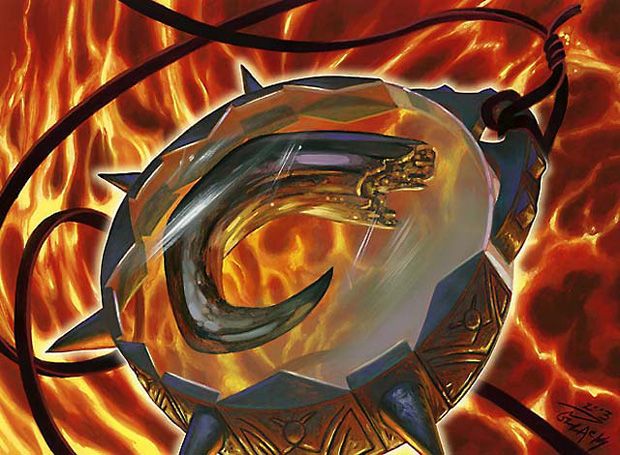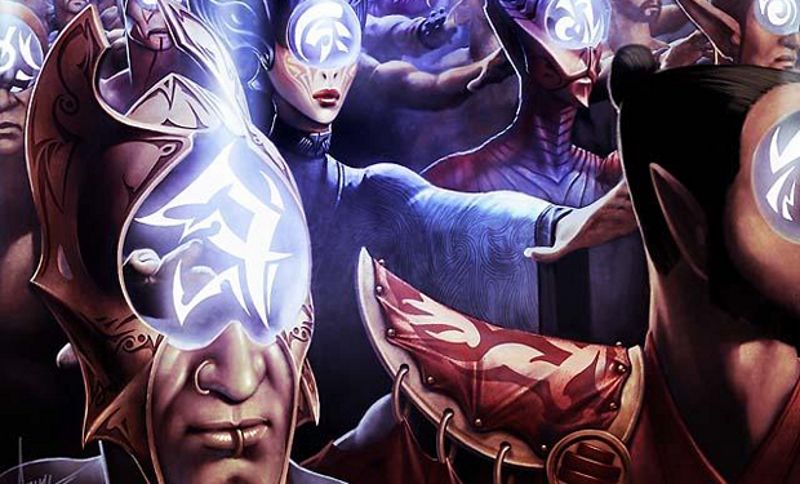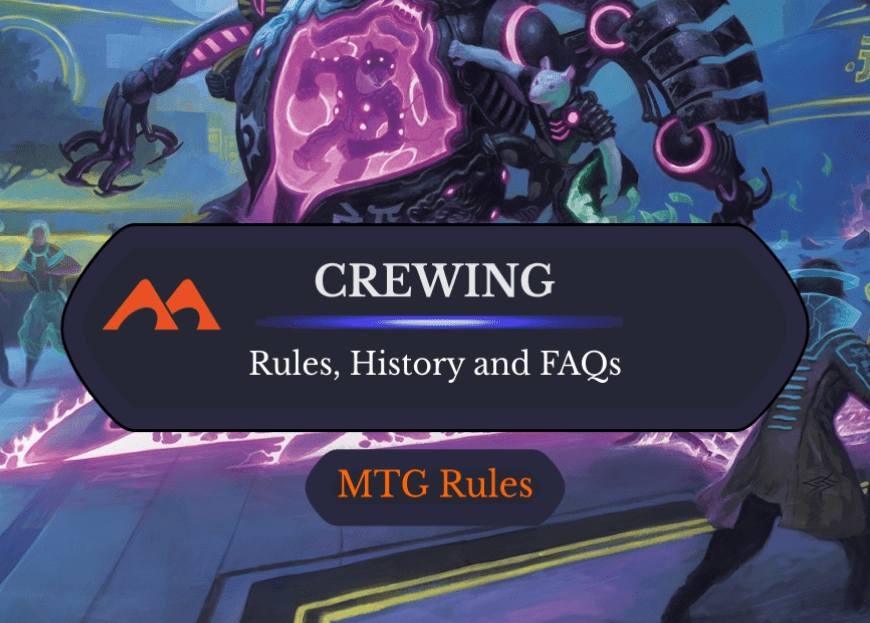Last updated on February 28, 2024

Play of the Game | Illustration by Jung Park
Magic: The Gathering is an ever-changing thing. Each edition sees the terminology and the rules of the cards evolve as the game designers see fit. MTG boomers out there remember terms like “bury” and “remove from play,” or what we now call destroy and exile. In the game’s 30-year history, some terms have come and gone. Others have changed over time, including “casting” and “playing” cards.
In MTG’s early days, playing and casting used to be different things. Then Sixth Edition came along and changed some stuff until the retcon changes in Magic 2010. But it’s all very confusing, especially for newer players. Can I get lands with my Gonti, Lord of Luxury’s triggered ability? What if the card is exiled with Laelia, the Blade Reforged? Is there any difference?
Stay with me and you’ll get the answers to these questions and much more!
What Is The Difference Between Playing and Casting?

Angel's Feather | Illustration by Alan Pollack
Simply put, you play lands but you cast spells (instants, sorceries, creatures, etc.). When a card says that you may play cards from the top of your library, there’s no distinction. In this case, you play lands from the top of your library, and “playing” spells from here is equivalent to “casting” them. Playing lands doesn’t use the stack, but casting spells does.
To sum up:
- Lands: Always played.
- Spells: Casting is the rule, but when a spell or effect allows you to play a given card, and it’s a spell, it’s the equivalent of casting it.
For example:
- Chandra, Pyromaster’s second ability states that you can exile the top card of your library and play it. You can’t possibly know if it’s going to be a land or spell, so in this case, play is being used in the wider sense. It applies to lands and spells.
- Oracle of Mul Daya lets you play lands from the top of your library. You can only play lands, and it won’t do anything if the top card is a spell.
- Villainous Wealth says that your opponent exiles X cards from the top of their library and you may cast only the spells exiled. In this case, you won’t be able to play lands exiled with Villainous Wealth.
What Counts as Casting in Magic?
Casting is the act of paying the cost of the spell, putting it on the stack, and resolving it. Sometimes you can cast the spell without paying its mana cost. You may cast spells from your hand, from your graveyard (e.g. the flashback mechanic), from the top of your library (Future Sight), or from exile (Reckless Impulse). You always cast spells and never cast lands.
The Rules for Play vs. Cast

Dragon's Claw | Illustration by Alan Pollack
According to MTG’s Comprehensive Rules, here’s the formal difference between play and cast:
701.4.
“To cast a spell is to take it from the zone it's in (usually the hand), put it on the stack, and pay its costs, so that it will eventually resolve and have its effect. A player may cast a spell if he or she has priority. To cast a card is to cast it as a spell”.
701.12.
“To play a land means to put it onto the battlefield from the zone it's in (usually the hand). A player may play a land if he or she has priority, it's the main phase of his or her turn, the stack is empty, and he or she hasn't played a land this turn. Playing a land is a special action, so it doesn't use the stack; it simply happens. To play a card means to play that card as a land or to cast that card as a spell, whichever is appropriate.”
As you can see, the main differences are:
- Casting a spell uses the stack and you must have priority to cast it. The stack doesn’t need to be empty and the spell resolves.
- To play a land, you must have priority during your main phase when the stack is empty. It doesn’t use the stack because it’s a special action.
The History of Play vs. Cast MTG

Hive Mind | Illustration by Steve Argyle
Before Sixth Edition (6ED) rules, spells were cast. This terminology can be found on cards like Gloom, Verduran Enchantress, Iron Star, and Throne of Bone. Then 6ED came along and changed the instances of cast to play.
Let’s compare the Throne of Bone from Fourth Edition (4ED) to its Sixth Edition printing. The 4ED text reads, “gain life when a black spell is successfully cast”, while the 6ED text says: “Whenever a player plays a black spell, you may gain one life.”
Some other cases include Aether Storm and Future Sight. Aether Storm in Homelands had the text: “No summon spells may be cast.” In future reprints, it changed to “creature spells can’t be played.” The first version of Future Sight stated that you can “play the top card of your library”.
This terminology caused some confusion because “play” has multiple meanings: “in play”, “play a card”, “play with the top of your library revealed”, and so on. Magic 2010 (M10) rectified that, and “cast” returned after that set’s rule changes. Play is now used in some situations, like play a land, play with the top of the card revealed. But you now cast spells, and permanents are on the battlefield, not in play.
Here’s a list of M10 cards that have the cast terminology according to the M10 rules.
- Angel's Feather
- Demon's Horn
- Dragon's Claw
- Fireball
- Gargoyle Castle
- Hive Mind
- Kraken's Eye
- Lurking Predators
- Mesa Enchantress
- Mold Adder
- Silence
- Wurm's Tooth
In the same set, Djinn of Wishes says that you can reveal the top card of your library and play it without paying this mana cost. This terminology is used when you don’t know what you’ll be revealing. Let’s see how the text of Future Sight evolved over the years:
- Onslaught (2001): You may play the top card of your library as though it were in your hand.
- Modern Horizons (2019): You may play the top card of your library.
- Secret Lair Drop (2023): You may play lands and cast spells from the top of your library.
Does Putting into Play Count as Casting?
No, it doesn’t. Casting a spell is different from putting a permanent into play. A classic card like Show and Tell says that “each player may put an artifact, creature, enchantment, or land card from their hand onto the battlefield.” In this case, after Show and Tell resolves, the cards just enter the battlefield naturally, so they don’t use the stack and there can’t be any response like a counterspell.
Is Play a Cast Trigger?
Playing a land doesn’t cause a casting trigger. However, playing a spell there causes a casting trigger, triggering permanents that care about casting spells. It also triggers cards that care about permanents entering the battlefield (if the spell resolves), and so on.
Are Casting and Copying The Same Thing?
They aren’t. When you copy a spell, you’re not casting it. There are even cards that care about one but not about the other. Commanders like Kalamax, the Stormsire and Parnesse, the Subtle Brush only care about a spell being copied, while the magecraft mechanic and Ral, Storm Conduit care about both copying and casting a spell, and thus have a wider application.
Do You Cast or Play Lands?
You play lands. Your opponent can’t respond to a land being played and you hold priority after that. Also, the red impulse draw mechanic (present in Act on Impulse) usually states that you may play cards exiled. Since you can’t know which cards will be exiled with Act on Impulse, if it’s a land you’ll play it, and if it’s a spell you’ll cast it.
Wrap Up

Mesa Enchantress | Illustration by Randy Gallegos
As Magic rules settle in, we have fewer alterations of terminology to worry about. Yes, some terms are changed here and there like milling cards, or “create a token” instead of “put a token onto the battlefield.”
But this knowledge is useful because it helps us in some situations. Now I know that I can’t put lands in play with Gonti, Lord of Luxury because Gonti only allows me to cast cards, but I sure can with Laelia, the Blade Reforged since it allows me to play cards, including lands.
It’s confusing, I know. But the more you play with these cards, the more you’ll be able to spot the difference. Plus. there’s always MTGO and MTG Arena to help you with the specific ruling. Was this text useful? Was there a rules issue you didn’t previously know? Let me know in the comments below, or leave us a message on Draftsim Twitter.
Stay safe folks, and thanks for reading.
Follow Draftsim for awesome articles and set updates:

Add Comment